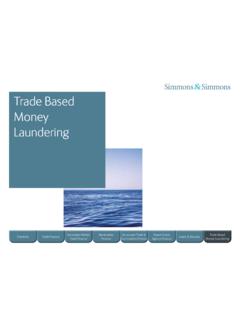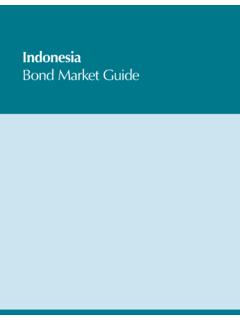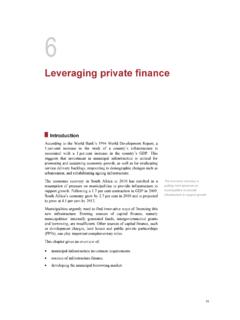Transcription of Committee on the Global Financial System
1 Committee on the Global Financial System CGFS Papers No 50 trade finance : developments and issues Report submitted by a Study Group established by the Committee on the Global Financial System The Group was chaired by John J Clark, Federal Reserve Bank of New York January 2014 JEL Classification: F10, F34, G21 This publication is available on the BIS website ( ). Bank for Internatio na l Settlements 201 4. All righ ts res erved. Brief excerpt s may b e reproduced or translated provided the source is stated. ISBN 92-9131-309-2 (print) ISBN 92-9197-309-2 (online) CGFS trade finance : developments and issues iii Preface Historically, the Global trade finance market was considered liquid and well-functioning.
2 But more recently, it has experienced periods of stress, most notably right after the Lehman bankruptcy in 2008, and also appears to be undergoing incipient structural change. At the same time, recurrent data gaps have made it difficult to assess the extent and impact of recent dislocations, and to track and evaluate the importance of current market dynamics. Against this background, in November 2012, the Committee on the Global Financial System (CGFS) established a Study Group (chaired by John Clark, Federal Reserve Bank of New York) to improve central banks understanding of trade finance markets.
3 This report presents the Group s findings. It examines the structure and recent evolution of the trade finance market , and the interplay between changes in trade finance and international trade . In particular, it reviews the available data sources and what they reveal about the size and evolution of the market , sheds light on the performance and impact of trade finance during recent episodes of funding strains in Global markets, and examines how ongoing structural changes may affect the market s future resilience. In terms of Financial stability risks, it concludes that losses on trade finance portfolios historically have been low.
4 Moreover, given their short-term nature, banks have been able to quickly reduce their exposures in times of stress. However, this latter feature also introduces the possibility for trade finance to act as a conduit of stress from the Financial System to the real economy, when banks run down trade finance books in response to funding and liquidity strains. As a result, policies that broadly address banking System capital and liquidity vulnerabilities and encourage vibrant competition are found to generally provide an effective means for avoiding or containing disruptions to trade finance flows current regulatory efforts clearly work in this direction.
5 The data, concepts and policy implications described in this report are a timely contribution on an important, yet under-researched topic. I hope that the report will inform ongoing discussions among the market and policymaking communities and become a standard reference on trade finance in the literature. William C Dudley Chairman, Committee on the Global Financial System President, Federal Reserve Bank of New York CGFS trade finance : developments and issues v Contents Preface .. iii Contents .. v Executive summary .. 1 1. Introduction .. 3 2. The role of banks in supporting international trade .. 3 3. Measuring bank-intermediated trade finance .
6 5 4. Global trade finance markets: structure and recent trends .. 8 The structure of bank-intermediated trade finance : an interpretation .. 8 Bank-intermediated trade finance : recent trends .. 16 5. trade finance : the potential impact on Financial stability and the real economy .. 21 The impact of disruptions in trade finance .. 21 The low-risk nature of trade finance .. 25 6. Distributing trade finance assets to non-bank investors .. 27 7. Policy implications .. 29 Enhancing the stability and resilience of trade finance .. 30 Monitoring trade finance 32 References .. 35 Appendix 1: Study Group mandate.
7 39 Appendix 2: Background on trade finance and trade credit .. 41 Appendix 3: Further information on trade finance data .. 44 Appendix 4: Estimating the size of the Global bank-intermediated trade finance market .. 45 Appendix 5: Recent regulatory reforms and trade finance .. 47 Appendix 6: Overview of the literature .. 50 Appendix 7: The determinants of trade finance and the impact of trade finance on trade : some Group estimates .. 56 CGFS trade finance : developments and issues 1 Executive summary This report examines the structure and recent evolution of the Global trade finance market and the interplay between changes in trade finance and international trade .
8 In particular, it gauges the size and evolution of the market , sheds light on the performance and impact of trade finance during recent episodes of funding strains in Global markets, and examines how ongoing structural changes may affect the market s future resilience. It draws on a range of data sources, outreach to experts in the private and public sector, a review of the available literature, and new statistical analysis conducted for this report. The key findings are: The role of bank-intermediated trade finance . Bank-intermediated trade finance (or trade finance , in short) performs two vital roles: providing working capital tied to and in support of international trade transactions, and/or providing means to reduce payment risk.
9 The principal alternative to bank-intermediated products is inter-firm trade credit. Firms ability to directly extend credit is supported by possibilities to discount their receivables and the availability of financing not directly tied to trade transactions, as well as possibilities to mitigate payment risk by purchasing trade credit insurance. Data coverage. There is no comprehensive source for measuring the size and composition of the trade finance market . Aspects of bank-intermediated trade finance are captured by statistics in many CGFS member countries, but coverage differs significantly across countries, and in many cases is quite limited.
10 Combining these data with information from other sources, such as trade associations and SWIFT, can support a general characterisation of the size, structure and trends of the Global market , but the approach requires significant interpolation and inference. Visibility into trends in pricing is very limited. Size and composition of the trade finance market . The Group estimates that trade finance directly supports about one-third of Global trade , with letters of credit (L/Cs) covering about one-sixth of total trade . However, the proportion varies widely at the country level: bank-intermediated products are primarily used to finance trade involving emerging market economies (EMEs), particularly in Asia.

















